Aiming for Google's top spot? Well, you´ll need a reliable ally — relevant backlinks!
According to our survey, 84.6% of respondents identified link relevance as the primary metric for assessing the quality of a backlink.

Relevant backlinks are links from authoritative sources that lead to your own site and are related to your content's topics, industry, or niche. They enhance your backlink profile, boost search engine rankings, and enhance your website's credibility.
Sounds like just what you need! Questions already? Keep up with me for tips on relevant link building and answers to popular queries like:
- What are relevant backlinks in SEO?
- What are niche-relevant backlinks?
- Is link relevance important for SEO?
- What makes backlinks relevant?
- What are relevant backlinks examples?
- What are non-relevant backlinks examples?
- How to get relevant backlinks?
- What types of relevant links we recommend?
What Are Relevant Backlinks in SEO?
Say, your company specializes in offering sales automation tools for small businesses. If you are featured as a top solution in influential blogs reviewing sales automation tools, you will get relevant backlinks for your business.
Yet, there’s more to relevant link building. You can significantly revamp your website's SEO by using niche relevant backlinks — a more narrow-targeted breed of relevant backlinks. Let me break this down for you.
What Are Niche-Relevant Backlinks?
Niche-relevant backlinks are links from websites in the same category or field as yours. When reputable websites in your niche link to your content, it shows search engines that your site is an expert in that specific area, improving your website’s authority and ranking.
If you pitch stories that fall squarely in your niche, you’re much more likely to get a backlink or quote. The biggest shift in our conversion rate came from narrowing our focus.
The major advantage of using niche-relevant backlinks is that they draw genuinely interested visitors. Hence, in the long run, you’ll benefit from longer time spent on your website, lower bounce rates, higher CTRs and better conversions.
Let’s reconsider our previous relevant backlink example. A good illustration of a niche-relevant backlink would be getting featured in a podcast hosted by a Saas industry influencer. While they talk about the benefits of your sales automation tool, your product will be advertised to a specific audience of professionals and potential customers.
💡Pro-tip! Leverage niche-relevant backlinks to improve the geographical relevance of your links aka local SEO. For instance, for a pastry shop in Mexico City, a link from a local food blogger has more relevance than one from the beach area of Tulum.
Is Link Relevance Important for Ranking in SEO?
Link relevance is vital for SEO as it ensures valuable information aligns with users' search intent. By matching content and backlinks with user expectations, websites enhance user experience, gain recognition from search engines and rank higher.
Alternatively, if your link lacks relevance, search engines may disregard it, pushing your website down in search results.
Link relevance often goes hand-in-hand with link authority. The latter shows how trustworthy a web page and domain is, based on the quality and number of links it receives from other sites.
Many SEO experts consider both link relevancy and link authority to be defining characteristics of high-quality links. And, indeed. Ideally, every top-tier link should come from sites that are both authoritative and highly-relevant to your own.
However, expert opinion still varies on whether relevance surpasses authority, or vice versa. Considering how easily SEO pros can secure backlinks from high-domain authority (DA) sites these days, relevance is getting more and more overlooked. This trend is backed up by a Backlinko study, which asserts a strong correlation between a site's overall link authority and higher rankings.
Ricky Davies, Managing Director of digital PR agency Weeare.co.uk, also endorses this concept:
Both relevant and authoritative links are needed to rank in competitive industries. While relevance is important and you should always look to build relevant links, if I had to pick one link alone, I would choose the highly authoritative link.
We work with clients in the gambling and casino industry, a niche that is often plagued with low-quality links. For our clients, we mostly try to earn links from authoritative sources. And while we can’t always be super relevant, links earned from highly-authoritative websites help our clients increase search visibility, rankings and ultimately sales.
Or, here's how Shawn Plummer, CEO at Annuity Expert, puts it:
If I had to choose between different types of links, I would certainly go with a link from a high authority website even if the link’s relevance is low. Building relevant links is important, perhaps more important than it ever was given the impact of Gen AI on content and search, but it’s the high authority links that really matter and count when it comes to link building.
Nevertheless, a fair share of SEO experts still tend to prioritize relevance over authority for several key reasons:
User intent optimization: aligning link content with user search intent allows SEO experts to boost user experience and elevate engagement metrics such as time on page and click-through rates.
All other metrics being equal, I’d go for relevance over authority. The simple reason for this is conversion. Sure, a link to a high-authority site does wonders for SEO, but how many people who see your link in that article would actually take interest in what you have to offer? In a high-relevance placement, chances are the reader has at least some tangential interest in your offer. Thus, there is a higher chance that they’re indeed looking for a service like yours
Natural link building: websites prefer linking to content related to their own, hence staying relevant helps attract good quality links.
Top-tier traffic: links from relevant sources drive targeted traffic to a website, increasing the likelihood of conversion as visitors are already interested in the discussed topic or product.
When it comes to the choice between link relevance and authority, I lean towards relevance. To me, relevance is about making sure your links come from spaces that truly align with what you’re all about. It’s like being at a party and choosing to chat with someone who really gets your interests over the most popular person in the room. Sure, authority has its perks, but relevance tends to hit closer to home, creating connections that genuinely matter. The goal is to strike a balance, but when forced to choose, relevance often provides more sustainable benefits by closely aligning with your audience’s interests and needs
Mitigation of penalties: prioritizing relevance mitigates penalties and secures long-term visibility in SERPs, as search engines penalize manipulative link-building and irrelevant links.
Improved local SEO: local SEO focuses on optimizing content for specific locations, guaranteeing visibility in relevant local searches.
From my experience, I’ve consistently observed that a highly relevant link, even if it’s from a lower authority site, tends to yield more beneficial results for small businesses. By securing backlinks from local food bloggers and community event pages rather than focusing on garnering attention from high-authority, but less relevant sites, we witnessed a notable uptick in the bakery’s website traffic and, importantly, in foot traffic to the store. These outcomes reinforced the idea that in the context of local businesses, the relevancy of a link often outweighs its authority because it targets a more concentrated and relevant audience, leading to higher engagement and conversion rates
Better content quality: focus on relevance fosters creation of top-notch, informative content. This content naturally garners more backlinks and social shares, solidifying the website's authority over time.
💡Did you know? Link builders rate creating link-worthy content as the most effective link building tactic.
Algorithm updates: as search engine algorithms evolve, relevance takes center stage in ranking criteria. Innovations like Google's BERT prioritize understanding language nuances, making relevance crucial for achieving high rankings.
Adaptability: relevance ensures SEO strategies adapt to evolving search trends and user behaviors. Staying current with topics and interests maintains website visibility and competitiveness in search.
Long-Term Success: building a network of relevant links ensures that a website remains connected to its niche community, fostering continued growth and engagement over time.
Setting aside debates, let's unite on this: securing backlinks from high authority domains bolsters website credibility, while relevant backlinks improve SERP rankings. Thus, balancing authority and relevance is key for your SEO strategy. Each aspect offers a unique advantage, paving the way for your website's success.
Having a mix of high authority and relevant links can create a more natural and diverse link profile. An overemphasis on high authority links, especially if they are less relevant, can potentially trigger spam signals to search engines.
That being said, the ideal scenario is to have a link that is both highly relevant and high authority. But if you have to choose between the two, prioritizing relevance can lead to more targeted traffic, engaged visitors, and potential for further link building opportunities
How Google evaluates link relevance
Google’s approach to evaluating backlink relevance is more sophisticated than ever, relying on advanced mechanisms to assess the contextual connection between pages. One such concept is Anchor Mismatch Demotion, referenced in Google’s documentation. This suggests that backlinks may lose value—or be outright ignored—if the content on the linking page does not align with the subject matter of the destination page.
Google also employs tools like topic embeddings and web entities to analyze content on a semantic level. These technologies go beyond surface-level keywords to understand a webpage's meaning and thematic connections, ensuring that backlinks genuinely reflect topical relevance. If a backlink fails to align meaningfully with the linked content, search engines may devalue it entirely.
Thus, when building backlinks, focus on securing links from content that shares a strong thematic connection with your own. This prioritization of relevance often outweighs other metrics like domain authority or sheer link quantity, ultimately delivering better SEO results.
What Makes Backlinks Relevant?
Backlinks are considered relevant when they contribute to the credibility, authority and topicality of the linked content. Here’s what else makes backlinks relevant:
- Topical relevance
- Geographical relevance
- Temporal relevance
- Anchor text
- Semantic relevance
- Target audience alignment
- Domain authority
- Link placement
- Link diversity
- Link freshness
- Link naturalness
- Social signals
Topical relevance
It’s a parameter search engines use to figure out how accurately a webpage matches with users’ queries or content of a linked page. For instance, if you are interested in renewable energy and how it can crack down on carbon emissions, a relevant link for you would be a National Geographic post on how renewable energy helps in slowing down climate change.
💡Pro-tip! How to achieve topical relevance?
- Delve deeply into the keyword topics
- Explore closely related subjects
- Include lots of useful content and links on the keyword topics
Geographical relevance
Geographical relevance is when the linking and linked-to pages share a common location-based context. For example, if your travel blog focuses on European destinations, a link to a Paris hotel booking site fits perfectly—it aligns with the location and topic.
Google tends to favor backlinks from sources that are geographically relevant to your audience. Using systems like localCountryCodes, Google can determine the primary country or region a webpage relates to and give extra weight to links from that area.
Local backlinks are like endorsements from nearby, trusted sources. They’re more relatable to your audience, leading to better engagement, stronger connections, and often more conversions. A link from a regional website feels more natural and credible, making it more valuable in Google's eyes.
That said, links from outside your target region still hold value; however, they just might not pack the same punch as those closer to home. Focus on building a healthy mix, i.e. links that connect your site to your local audience, but also don’t overlook opportunities to earn high-quality links from global sources.
Temporal relevance
Temporal relevance is when offerings and content of linking and linked-to pages are timely and on-point. For instance, when a blog post talking about Christmas gift ideas links to a page with winter promotions, it’s considered to be temporally relevant — it fully aligns the context of seasonal shopping.
Anchor text
Anchor text is a clickable text in a link giving context about the linked content. For example, an article dwelling in effective link-building methods contains a link with an anchor text “Golden Rules of Link-Building”. It provides readers with a better idea of what they’ll discover when they click on the link.
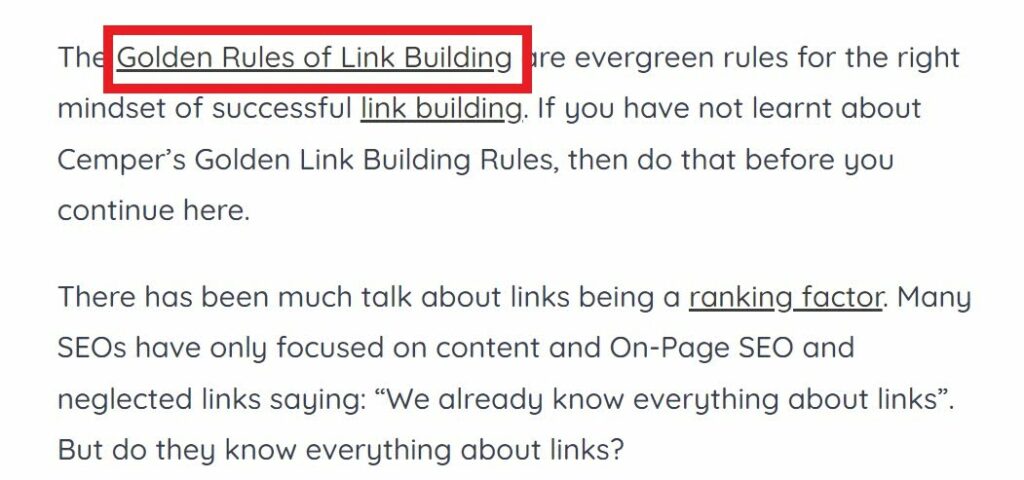
💡Pro-tip! Optimize your anchor text, but avoid overdoing it. It’s a myth that exact match anchor text backlinks are more effective for content ranking than non-exact match anchor text links. It’s because Google views exact match anchor text as an attempt to manipulate rankings. Prioritize diverse, relevant anchor texts, such as variations, branded text, and natural language phrases.
Semantic relevance
Semantic relevance occurs when there’s an alignment between concepts and meanings of linked pages.
For example, a post on climate change linking to a study on how to slow down climate change would be considered semantically relevant. That’s because both topics refer to a broader theme — environmental sustainability.
Target аudience аlignment
Backlinks turn out to be more relevant when they come from sites that appeal to a similar audience or niche. This ensures the linked content is contextually relevant to the interests and needs of this audience.
For instance, a DIY blog getting a backlink from a leading handmade magazine's site is highly relevant as both target audiences share an interest in crafts and handmade creations.
Domain authority
Domain authority shows a website's credibility and trustworthiness in search engine algorithms. 68.3% of SEO professionals consider domain authority one of the highly valued metrics.

One exemplary website with a high domain authority is Wikipedia.org. Its extensive content, longstanding presence, and widespread referencing contribute to its impressive domain authority score.
Link placement
Did you know that the exact position of a backlink in a piece of content affects its relevance? As a matter of fact, backlinks placed within the main body of an article or webpage prove to be more impactful than those in footers or sidebars.
Link diversity
Having backlinks from a variety of sources and domains shows search engines that the linked content is valued across different platforms and audiences. Plus, websites with backlinks coming from multiple sources like forums, blogs, directories, social media, news platforms are giving a more diverse and natural backlink profile.
Link freshness
It’s all about how recent your backlinks are. Google may give preference to fresh backlinks as they signal timeliness, ongoing relevance and popularity of the linked content.
For instance, if you recurrently get fresh links from reputable sources, your rankings will significantly improve.
Link naturalness
Or, in other words, organic links earned without manipulative or deceptive tactics. Natural backlinks are the ones that are regarded by SERP the most as they are based on the quality of linked content. For example, you naturally want to link to a blog post as you find it really helpful, but not because you were promised money or a mention in return.
Social signals
These are all sorts of engagement and attention your content gets on social media. While we cannot call them backlinks per se, social media spotlights can also improve your website’s online presence and credibility.
For example, an article getting multiple likes, shares and comments on LinkedIn will attract more traffic to the website where it’s been initially posted.
💡Pro-tip! If you create content, let it be highly-shareable or even viral as it generates 2-5 times more organic traffic and backlinks.
User engagement metrics
Bounce rate, time on page or click-through rate and other metrics can also, though indirectly,impact backlink relevance.
For instance, a web page getting high user engagement and visitors spending significant time reading its content, is more likely to attract quality backlinks from other websites seeking to reference valuable resources.

What Are Relevant Backlinks Examples?
Okay, now that you've grasped relevant link building theory, let's dive into practice. They say a picture is worth a thousand words, so here's our curation of safe relevant backlink examples.
Example #1
In the given example, there's a link within a guest post on Search Engine Land website, discussing the benefits of outsourcing link building. The link point to the Editorial Link, a reputable link building agency.

Placing a link on the authoritative website for SEO specialists isn’t the only benefit here. By mentioning this link-building agency, Search Engine Land recommended it as an effective service to individuals in need of quality backlinks reading this blog post.
Hence, what makes this link relevant is target audience alignment. How come? Well, it matches interests and needs of the blog’s niche audience who were initially attracted by the article’s narrow topic.
Example #2
Here’s another instance: a link pointing to our client, Sitechecker, a website performance monitoring tool.
This link was featured in an article by Hubspot, which reviewed the most efficient SEO tools for auditing websites and suggested Sitechecker as an alternative option.
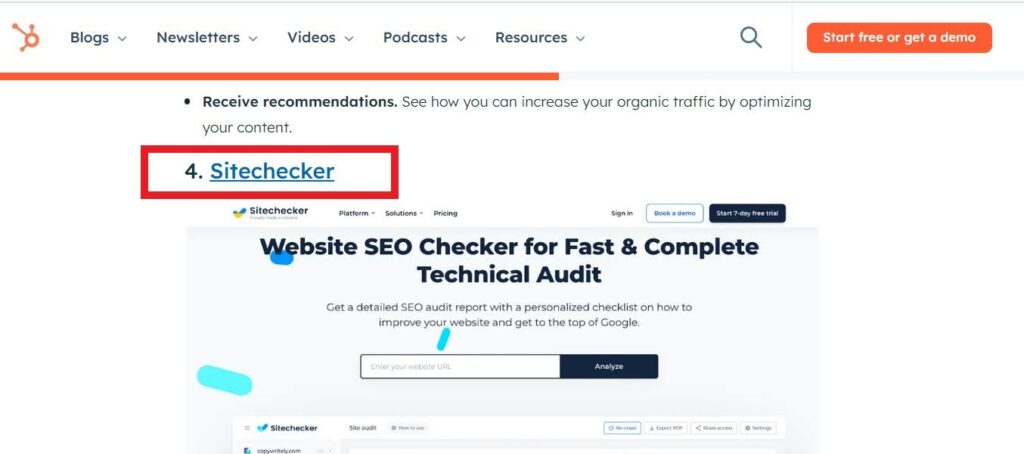
Setting aside the authority of HubSpot per se, this link automatically becomes relevant due to its topical relevance. When readers are looking for "Best SEO tools for auditing/monitoring websites," a link to the Sitecheker tool is considered by search engines as closely matching with their search queries. Consequently, redirecting readers straight to the page where they can explore the tool that meets their needs makes this link relevant.
Example #3
In this case, the link embedded within Meltwater's article contains the phrase "setting appointments," which directly addresses the query presented in the article's heading, "How a CRM system can help your business succeed." Upon clicking, the link leads to an article by Belkins focusing on practical strategies to enhance appointment setting.

To search engines, this link will be perceived as semantically relevant since it establishes connections between the concepts discussed across linked pages. If a reader is seeking insights into how CRM systems can enhance business processes, the hyperlink to Belkins will demonstrate precisely how a specific process, like appointment setting, can be refined using their tips.
Alternatively, a semantically relevant link can guide users not only to informative resources but also directly to a specific service provider offering certain solutions.
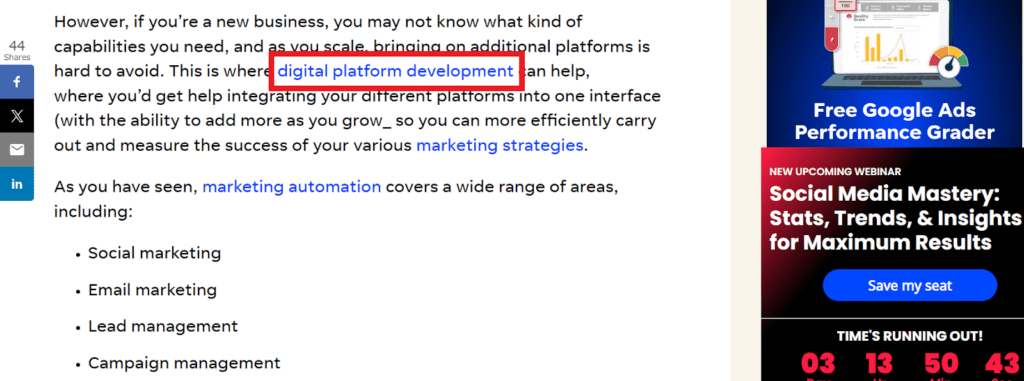
For instance, in a WordStream post, there's a link saying "digital platform development," hinting at another solution to enhance marketing automation tools. Clicking it takes you to Intellias, exactly offering quality digital platform development services.
🚨 Ready to rock search results with a relevant link of your own? There’s nothing easier! Get high-quality backlinks from authoritative websites like hubspot.com, podium.com, monday.com, and more with Editorial.Link. Your DR or DA doesn't matter — relevant links do. Contact us now!
What Are Non-Relevant Backlinks Examples?
While you already know what safe relevant backlinks should look like, it's important to understand what non-relevant backlinks are and why they should be avoided.
Non-relevant backlinks can range from spammy, low-quality links to those specifically designed to manipulate Google search rankings. It's important to spot and steer clear of irrelevant backlinks to avoid big drops in your rankings, traffic, or even getting removed from search results. Here are examples of links to refrain from using at all times.
1) Links from unrelated sources
If your website is about technology, but you have backlinks from sites about gardening or fashion, those links would be considered non-relevant. These links don't provide any context or relevance to your content.
I recently came across a LinkedIn article listing websites recommended for generating high-quality backlinks for free. While scrolling through usual platforms like Facebook and LinkedIn, I noticed Trepup, a social media platform I wasn't familiar with. Intrigued, I clicked on the link to explore further.
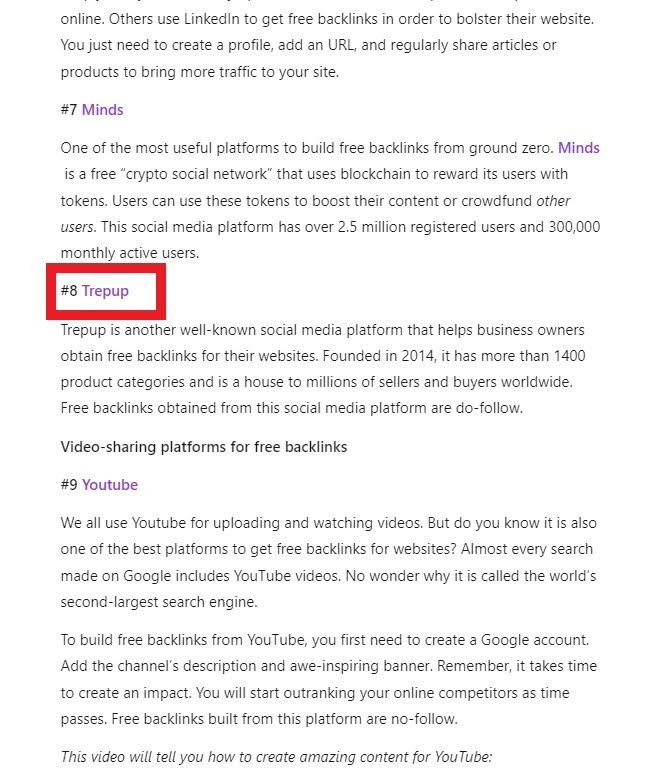
Surprisingly, the link redirected me to a website promoting a gym webpage! Upon further investigation, I found that all the other links in the list also directed to the same page gym. So, dear reader, I stumbled upon a classic example of content crafted purely for backlink generation – not only irrelevant but also spammy.
Out of sheer curiosity, I decided to investigate the gym's backlink profile with Ahref´s Site Explorer, only to find it shockingly lacking. It's no surprise the creator of that LinkedIn post was so eager to place numerous backlinks!
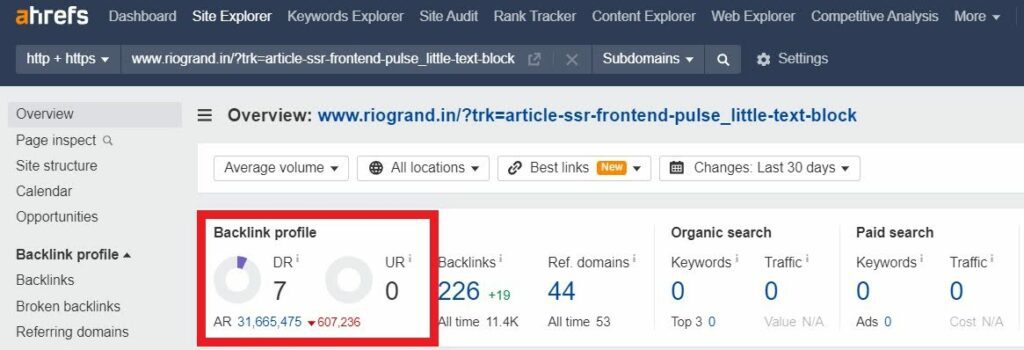
2) Hidden links
The example I mentioned earlier immediately brings to mind another black hat SEO tactic: the use of hidden links. It falls under Google's spam policies and, of course, is entirely unethical.
A hidden link is exactly what it sounds like: it's a link on a website that the owner intentionally hides from users and search engines. This can be done by using techniques like white text on a white background, hiding text behind an image, or linking a very small character, such as a hyphen within a paragraph.
💡Pro-tip! If a website offers you a link, whether free or paid, but insists on using a hidden link, steer clear. If you proceed, your backlink profile will surely be at risk.
Hidden links can be tricky to notice, but if you have a website monitoring tool, always check the anchors and surrounding text of the link you want to investigate.
If you're using Ahrefs, examine the links in the "Backlinks" dashboard. I decided to inspect the infamous gym website from the previous example for hidden links, and there it was! Normally, anchors like "sports goods and gym accessories" would lead to sports-related content, but in this case, it directed to "amusement and theme parks," completely unrelated and clearly meant to manipulate search engines.
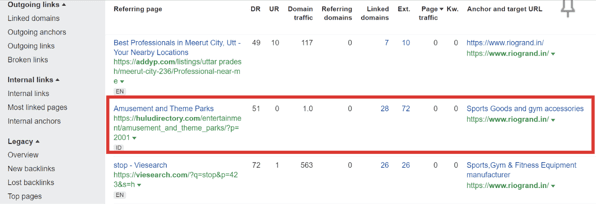
Moreover, when I clicked on "amusement and theme parks," I was taken to a website that didn't show any mention of "sports goods and gym accessories." It seems the link was hidden in the layout to drive traffic to the gym without visitors realizing it!

Also, take note of the website's nature. It's like a sketchy dumpster offering questionable services such as promises of cheap link building, and you can probably guess the rest.
3) Paid links
Buying backlinks that have zero connection to your content can backfire. Not only is it against the guidelines of the search engines but also tells them your backlink profile is not organic. Sadly, enticing offers for premium links saturate the internet, making it challenging to resist the temptation of shortcuts.
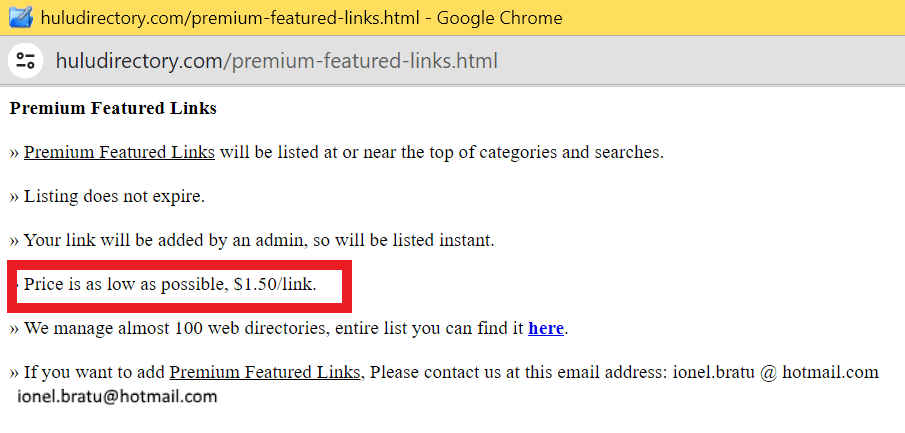
💡Pro-tip! Links bought in bulk and placed randomly on sites won't bring quality visitors to your site. They'll likely get flagged as spam by Google. Draw a clear line between paying someone for link-building services and buying links in bulk on suspicious websites offering quality backlinks for peanuts.
But don’t get me wrong. Google isn’t fully against paid links. As long as they have the right attributes like advertising and sponsored content, it’s okay to buy and sell them. The only requirement is that they should be marked as "nofollow" or "sponsored."

Fortunately, there are numerous high-quality industry-specific directories out there for you. For instance, if you specialize in law and are willing to build relevant links within the industry, resort to reputable legal directories.
4) Links from second-rate directories
As mentioned previously, I'm all for using established directories like Product Hunt, Crunchbase, Better Business Bureau or any other niche-specific directories.
They're extremely beneficial for boosting your business's online presence and reaching new audiences. But if you exhaust the accredited options and start appearing on every low-quality site, you're likely to spread spam-like vibes.
Consider the shady offer from the earlier example, which promised to place your links on multiple directories simultaneously.

Let’s pretend we bought the idea and see what’s out there.
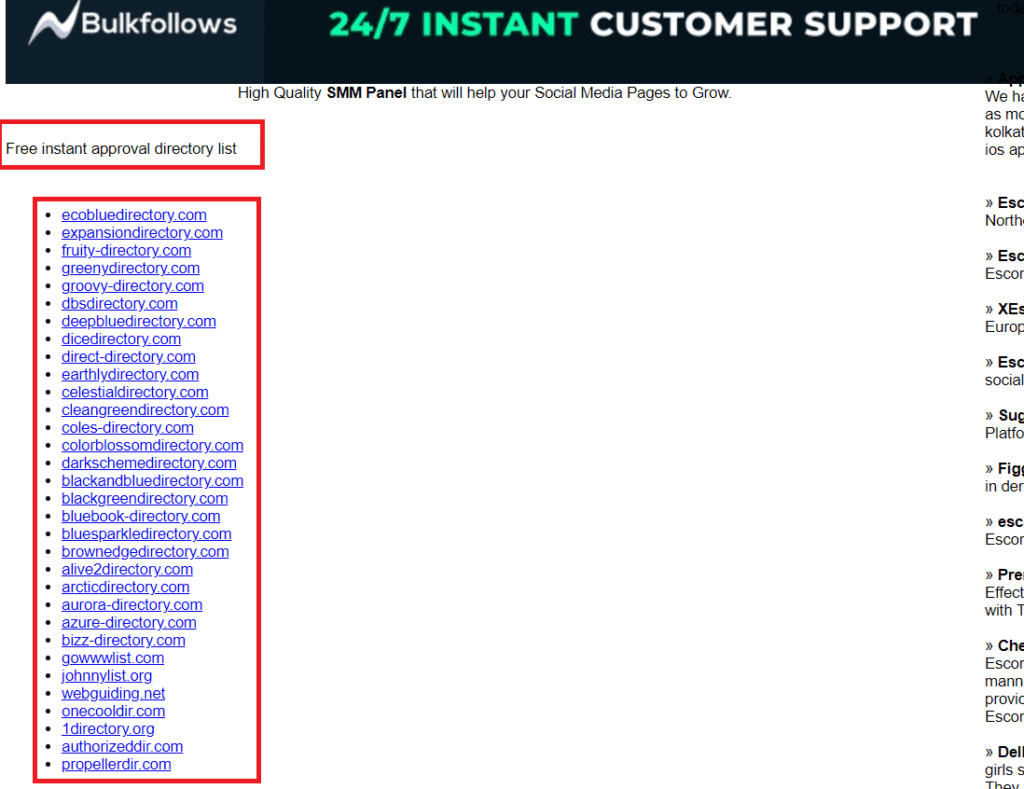
As expected, a directory list endorsing "instant link approval" immediately popped up. While it may seem tempting, especially for new entrepreneurs, remember that quality outweighs quantity when it comes to online visibility.
Just for the thrill of it, let’s check all these domains with Ahrefs Batch Analysis and figure out whether any of them carry any relevance.

As you may see, the majority of them are either broken, undetectable rubbish links or lead to zero-relevance directories with little to none traffic and high DR’s. This may point to the fact that all of them have been either mass generated or might be a part of sneaky networks like PBNs.
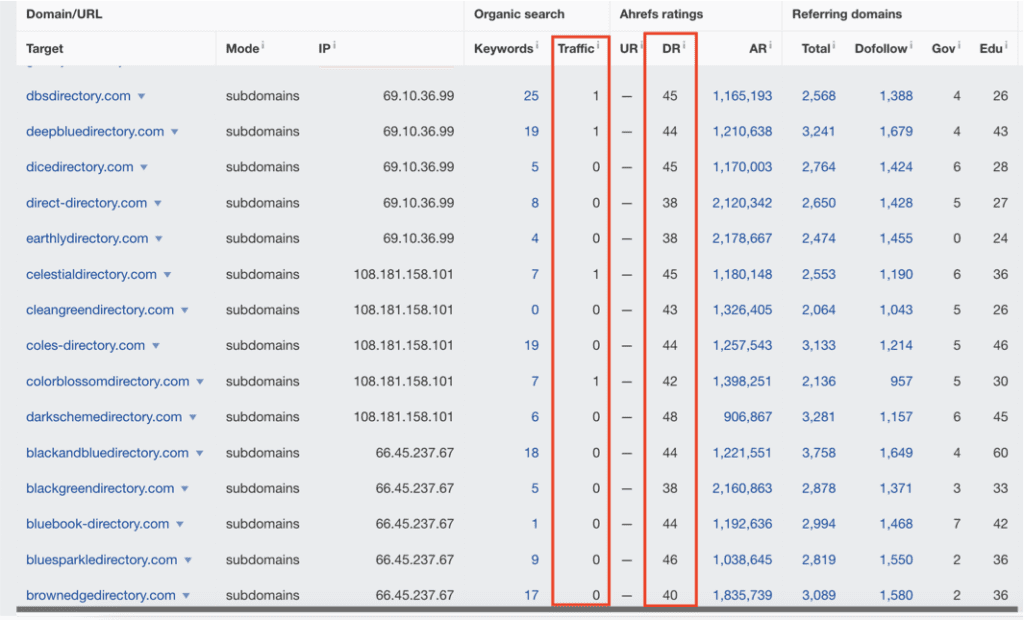
As you get it now, it's best not to risk associating your name with none of these low-quality directories.
5) Reciprocal links
Reciprocal links, or "fellow linking," are in the same category as paid links — not exactly harmful, but they require caution when used. The principle is simple: "I'll scratch your back if you scratch mine," meaning if you link to them, they'll link back to you.

Source: Ahrefs study
While effective in genuine partnerships, this practice has been abused to the extent that Google and other search engines view it with suspicion. That’s because "fellow linking" has become a prime hallmark of link farms, where countless websites link to each other without genuine relevance.
💡Pro-tip! Never accept offers for "fellow linking" unless you already have a pre-existing relationship with a business.
So, reaching out to hundreds of sites for link exchanges may make you look like you're involved in link exchange schemes. You can check any link for involvement in these schemes by going to your Site Explorer. Click on “Backlinks profile” > “Referring domains” and export the data.

Then, go to “Outgoing links” > “Outgoing links” report and export the data again.

Put all the exported data into a Google Sheet and search for duplicate domains.
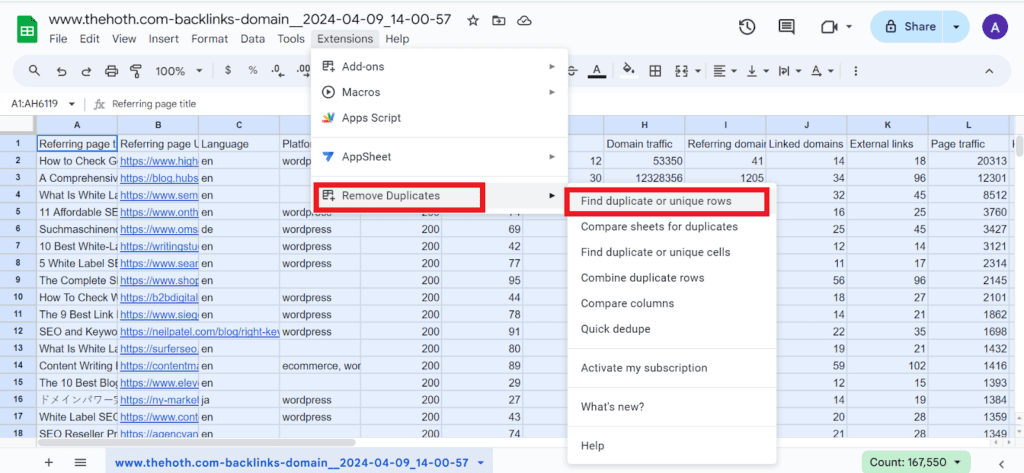
Finding duplicate domains is easier if you install the Google add-on "Remove Duplicates" before your analysis.

💡Pro-tip! Several reciprocal links is totally okay, though over 30 signals you might need to cut down on “fellow linking” to avoid search engine penalties.
6) PBN-borne links
These are links created by Private Blog Networks (PBNs), a group of websites owned by a single “parent website” interlinking to manipulate search engine rankings. Such networks can be really harmful for relevant link building as they are purely designed to simulate earned links, artificially generating trust signals and misleading both users and algorithms.
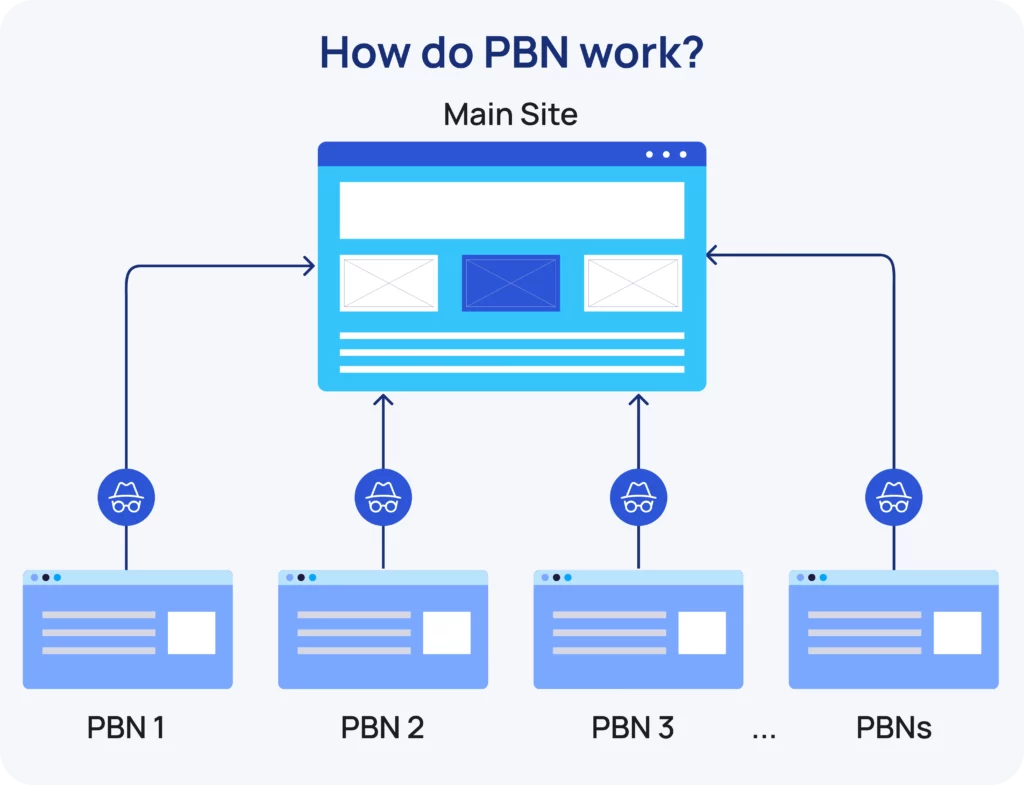
Usually, you can spot a suspicious domain linked to a PBN or bad backlinks by looking for certain signs: high DA/DR, low traffic, few top-ranking keywords, and minimal page traffic. Here's an example of using Ahrefs Site Explorer to check the backlink profile of shasanahmed.com.
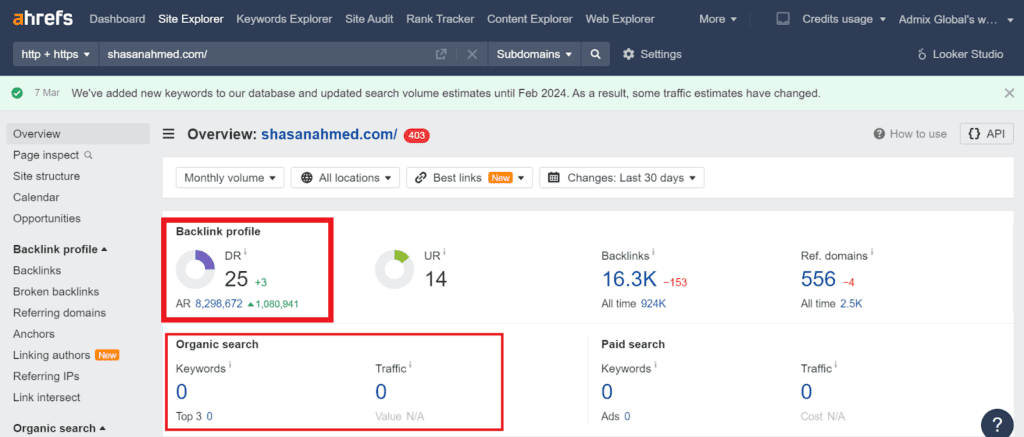
As you can see, the DA/DR appear fairly decent, meeting the recommended ratio of 25 or higher. However, other metrics are noticeably lacking.
To look for PBN presence, I usually check Backlinks and select the "Show history for all time" filter. That’s because PBNs often remove links after achieving their goal, so keeping the backlink history helps spot patterns.
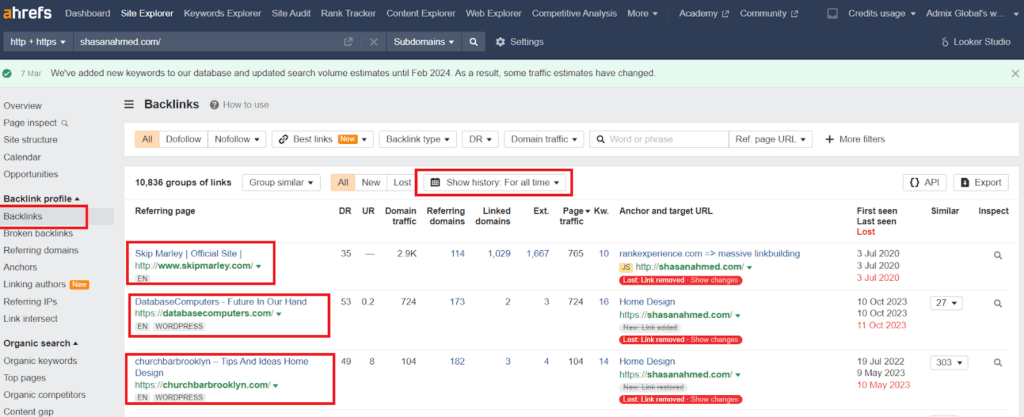
Upon investigation, I found several backlinks associated with the domain shasanahmed.com:
- skipmarley. com
- databasecomputers. com
- churchbarbrooklyn. com
Now, I can examine each of them to see if they share IPs, as many traditional PBN creators don't bother hosting each PBN domain on a separate server. To do this, we'll need to conduct a batch analysis of linked domains to identify any pattern. Here you go, a shared IP detected!

💡Pro-tip! Don't fool yourself — it's incredibly challenging to create an "undetectable" PBN. Just think about all the effort required to mimic the inner workings of real websites! Plus, to look “credible” a PBN must have its own distinct ownership, domains, or hosting providers to avoid flagging. Now you get me: it’s way more practical to put that much effort into securing safe relevant backlinks.
7) Hacked links
Hacked links happen when someone sneaks into a website and adds alien content to its pages. It's hard for website owners to spot hacked links as they look exactly like parts of the original content. Typically it’s done by malicious pros to make a website look as an authority on a particular topic.
Unfortunately, such sneaky tactics are common these days and go against Google's spam policies.
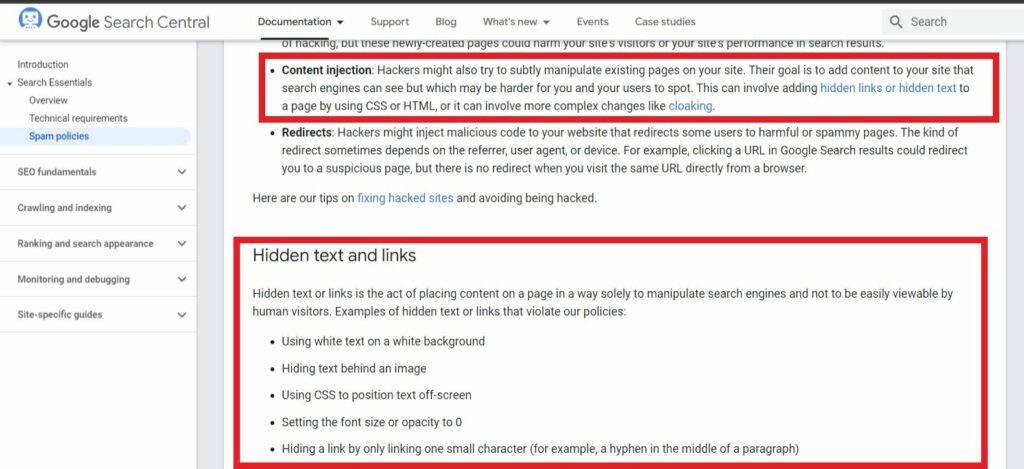
If your site has hacked links, the hacked website owner might tell Google or your hosting provider, leading to your site getting taken down.
This happens a lot, especially when site owners buy links from link building services for guest posting. The links they get might end up being hacked and eventually reported by the hacked website. So, the best bet is to either get relevant backlinks yourself or use a trustworthy link building provider.
8) Automatically generated links
Automated link building involves using tools to quickly generate numerous links to your website.These links often follow a tiered structure, where you create links directly to your site (Tier 1) and then create more links to the sites linking to yours (Tier 2, Tier 3, etc.).
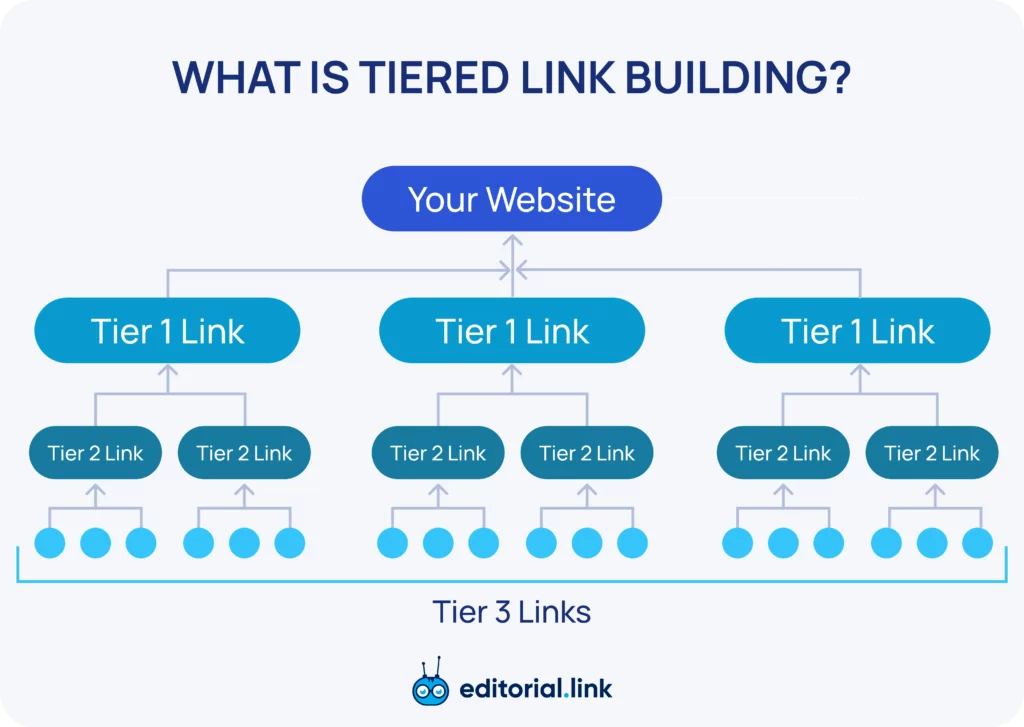
Usually found on low-quality web blogs, these links not only fail to benefit your site but also breach Google's link spam policy. If Google detects them, you could face penalties.
Automatically generated links are easy to spot because many different websites link to yours with the same (or very similar) titles and anchor text.

9) Links from comment sections & forums
There’s still much debate on whether forum link building is an effective source of relevant backlinks. Usually, placing links in forums’ comment sections is all about snagging quick traffic and boosting backlink numbers, rather than adding value to the conversation.
In the best case scenario, you´ll find snippets of commonly known Wikepedia-kind information on the discussed topic. But most often than not, you´ll bump into:
Spam: comment sections and forums are top-priority for spammers and those spreading malware. Clicking on these links can expose you to phishing attempts, viruses, and who knows what else. Here’s a classic example of a spammer promoting suspicious services with zero contribution to the conversation.

Anyway, my curiosity almost got me into trouble!
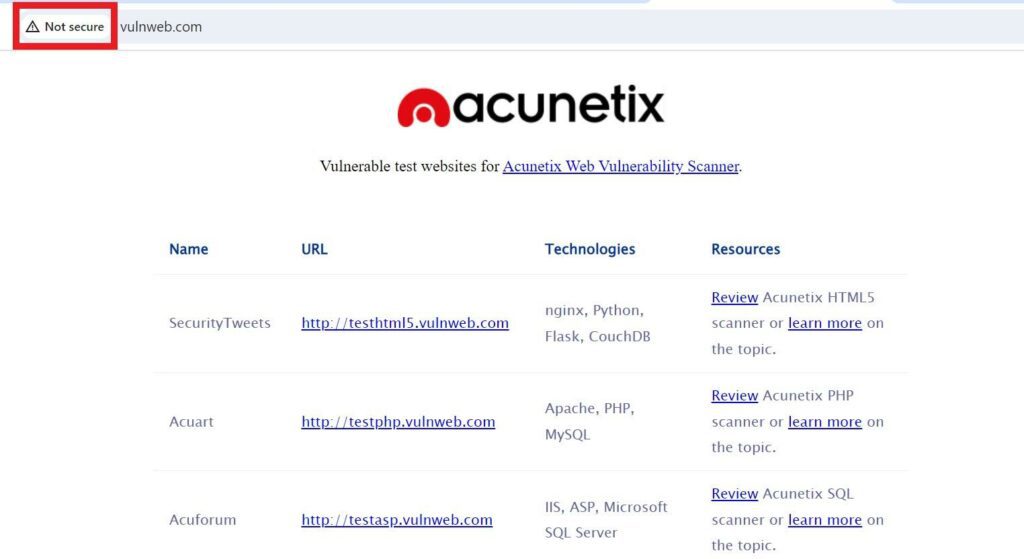
Thin content: the most widespread types include low-quality, click-bait articles or snippets of copy-pasted or AI-generated posts from online blogs that seem okay on surface, but still cannot be rated as valuable content.
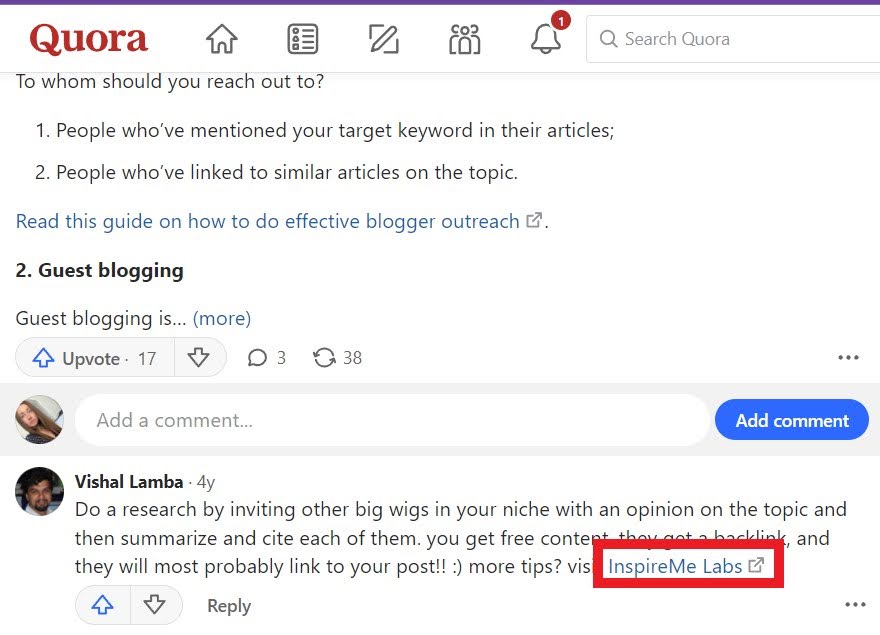
When I examined the link, I didn’t have high expectations for the blog. The content could have matched this Quora request, but the backlink profile said it all.

Off-topic content & context: sometimes forum users post links to articles, websites, and resources that have distant connection to topics mentioned in queries, which is not only distracting but annoying.

In this very instance, the link doesn’t complement the context of the latest trends in logistics and supply chains but redirects to the social media marketing section of Fiverr job seeking platform, which doesn’t help the case.
Broken & outdated links: another frequent occurrence are links in comment sections that lead to websites or pages that have been taken down, moved, or updated since the link was posted.

Although the anchor text of the link might seem promising, clicking on it will get you disappointed.

10) Farm-generated links
If you have never heard of them, link farms are multiple websites interlinking with each other to improve their search rankings. These provide users with links from random websites and irrelevant articles, making them useless for anyone seeking relevant backlinks.
Link farms are somehow similar to aforementioned PBNs with the only difference that PBNs redirect link users to external sites, while link farms are focused on interlinking within their own net of websites.
Regrettably, link farms are becoming increasingly common these days, especially when using third-party SEO services. If your search visibility doesn't improve post-purchase, check your provider’s links using Ahrefs. Farm-generated links typically show pretty same numbers of referring domains, similar DR, and poor traffic.
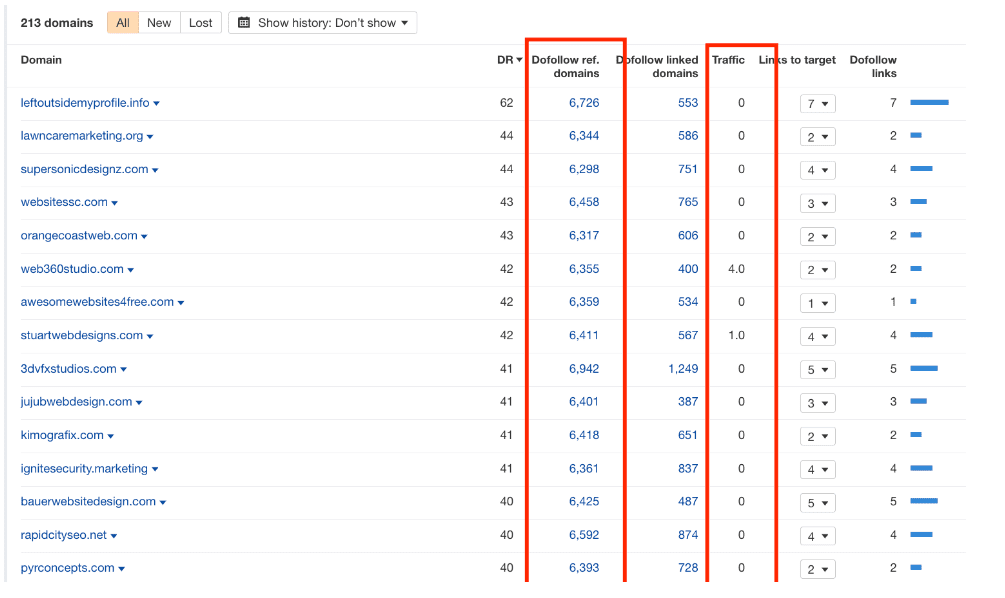
How to Get Relevant Backlinks?
To get relevant backlinks you need to implement backlink management techniques into your daily link building routines. The basic tips include:
- Monitor your backlink data
- Study your competitor backlinks
- Set up your link-building plan
Monitor you backlink data
To begin with, collect all data referring to your backlink profile using analytical tools like Ahrefs, SEMrush, or Google Search Console. These will help you figure the ratio between quality and spammy websites, boost your website authority, drive referral traffic, and most importantly, avoid penalties like deindexing in the future.
Do backlink profile audit
When proceeding with backlink profile audit, focus on the following key metrics:
Backlinks: put on your radar links from authoritative websites with high DR and robust traffic streams. The more traffic the link gets, the more chances bigger audiences will pass by your link and eventually click on it, enhancing your rankings.
💡Pro-tip! A quality backlink analysis is not only about how much traffic a link gets, but also where it comes from. The best thing you can do for your website is to hunt for links from domains that have a high amount of traffic coming from the geographies your business operates in.
Plus, don’t forget to check the relevance of the linking domains to your website’s niche or industry. Niche-relevant links are seen as more valuable for search engine algorithms.
Anchor text: make sure the anchor text of your backlinks is relevant and is totally natural aka containing keywords that precisely reflect the content of the linked page. In the same context, avoid over-optimized anchor texts as they can raise suspicion of search engines and result in immediate penalties.
💡Pro-tip! Constantly analyze the distribution of anchor texts used in your backlinks. Particularly watch for exact match anchor text instances. The recommended use of the same anchor text should not exceed 1-2 times per page so that search engines do not consider it a ranking manipulation attempt.
Ranking: another important metric that directly correlates with your conversions. However, always make a reality check: high rankings do not necessarily mean conversions, hence pay attention to other areas of page performance improvement like content quality, it’s relevance, referral traffic, or anything that will help you convert after rocking your rankings.
Check your spam score
This is another important metric to keep a grip on your website’s trustworthiness. Constantly check links from low-quality or spammy websites as these can bear malware, sites with a huge amount of outbound links and even adult content.
Plus, as we mentioned before, links from farms, second-rate directories and article submission websites can be seen as spam as in most cases they show zero relevance to linked websites. To release you from extra work, create a list of toxic or spammy links to avoid dealing with them later in time.
To automate your daily workflows, you may use different SEO tools to detect spammy, low-quality links. For instance, Moz uses such a metric as Domain Authority, additionally showing spam score ratio.
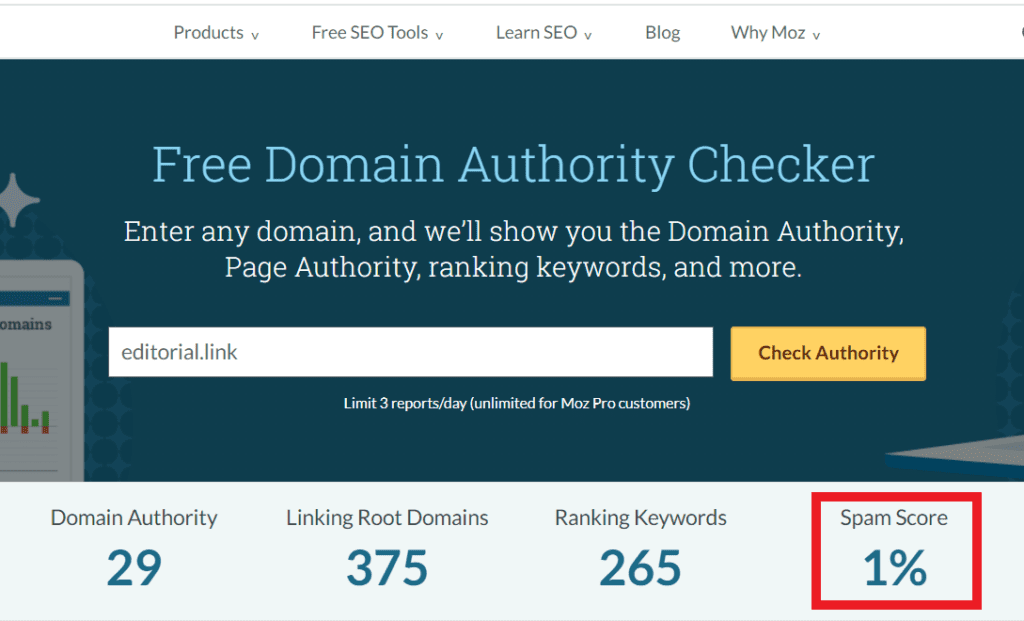
💡Pro-tip! To stay on the safe side, keep in mind the following ratios: 1-30% stands for low spam score, while 31-60% — medium, and 61-100% indicates high spam score.
Track your lost links
For the past 9 years, at least 66,5% of hard-earned backlinks have been irreversibly lost by businesses. In terms of SEO, the number is even higher —74.5%. This is a big no-no for link builders, especially if the lost link used to be highly-relevant. Here are the most common reasons for that:

Source: Ahrefs
If you are using Ahrefs, you may track your lost links by tapping on Backlinks side bar. You may also sort your results by Domain Rating, URL Rating, or Traffic to prioritize sites to reclaim your links later on (for instance, producthunt.com).
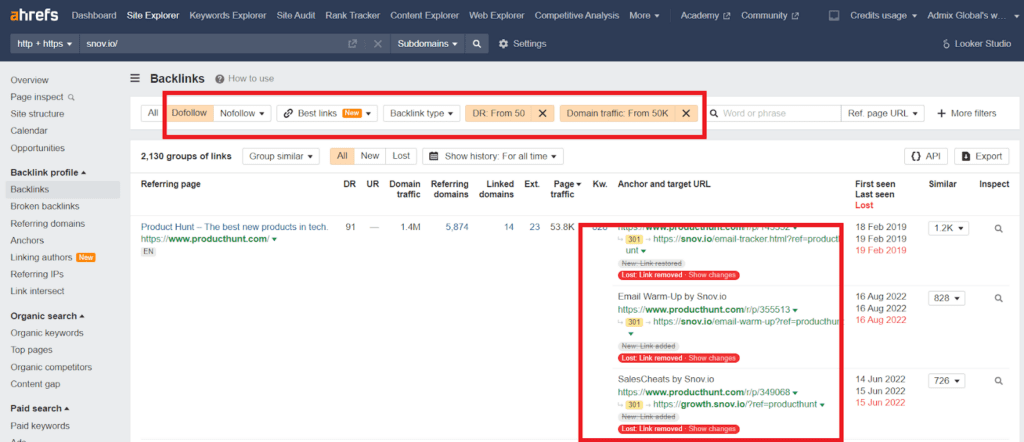
Analyze your link diversity
Make sure all your backlinks show a diverse range of sources, such as news sites, reputable blogs, social media platforms and highly-referred-to forums. This will give your backlink profile a natural vibe as genuine links do not rely on a single type of source only.
💡Pro-tip! Track for suspicious patterns in your backlink profile. For instance, an unusually high number of links from a specific website or even country can point to a manipulation attempt.
Study your competitors
Analyzing competitor backlinks is one of the best ways to catch up with the tricks other businesses already used to improve their link building efforts. The main advantage of this method is that you don’t need to waste time on experiments as you can directly track what exactly made your competitors outperform others. The only thing you need is to analyze their ways and apply these techniques into your own backlinking routines or content production.
💡Pro-tip! While peeping at your competitors' approaches to building relevant backlinks is great, entirely mimicking their strategies won’t take you far. Rather than linking to the same directories and listicles, you’d better analyze niches and industries their links have been relevant to. This will give you more insights into your own areas of focus.
Here’s one of the basic ways to track your competitors’ link building practices in Ahrefs.
First, type in a desired domain URL into the Site Explorer and tap on the Organic competitors tab to identify the core pool of your competition.
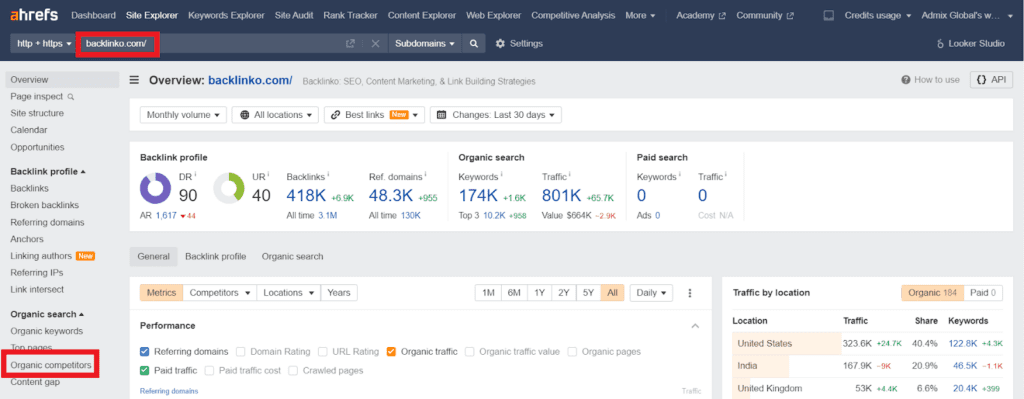
You may either be okay with the top 5 listed competitors or scroll through a more comprehensive list shown below.
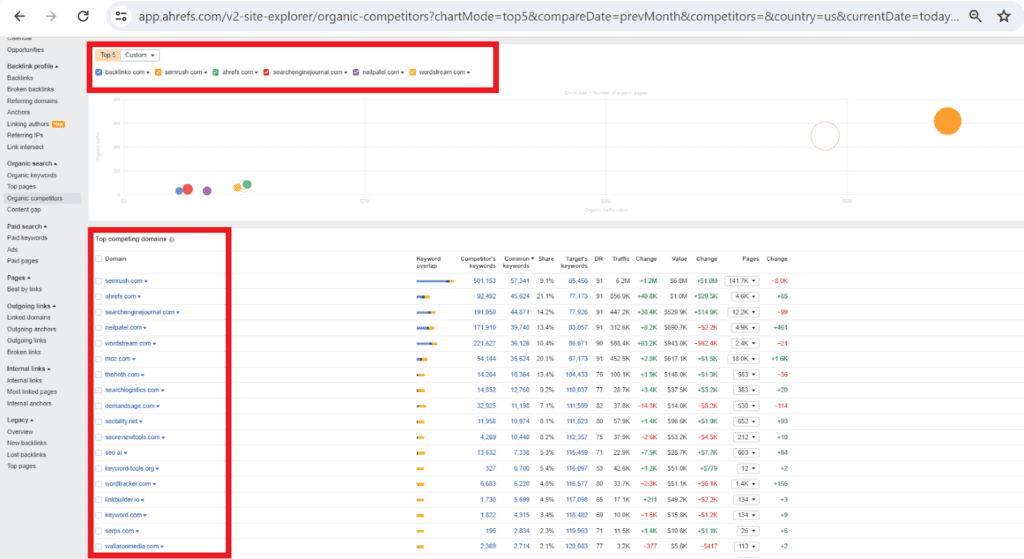
Additionally, you can get a more detailed overview of their performance by ticking on the entire list of competitor domains and choosing Overview 2.0 filter.
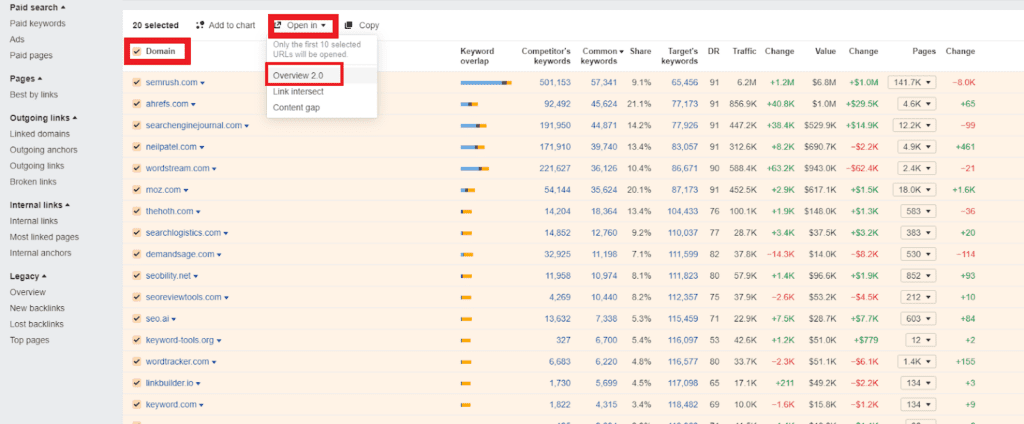
Here you may see a more detailed picture of metrics including traffic by location from top 5 competitors and other types of competitor performance all shown in charts and graphs.

Next, you may want to check out the Link Intersect tab to locate websites linking to your competitors. In the upper bar, type in URLs you want to check for linking to each other and exclude a certain URL that shouldn’t link to none of the competitors above. Press Show link opportunities and let the system respond.

Eventually you’ll be provided with a list of domains each of three competitors has a link to. The digits down each competitor column show how many links lead to a certain domain.
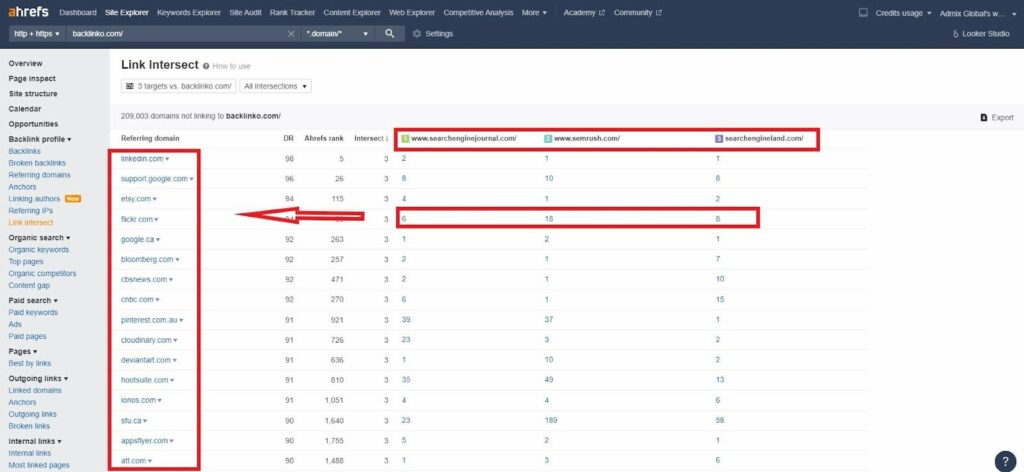
For instance, searchenginejournal.com has 6 links leading to domain flickr.com, while semrush.com — 18 links and seachengineland.com — 8. Let's click on any number, say number 6 in the column corresponding to searchenginejournal.com.

Below, you’ll be immediately shown all the links between searchenginejournal.com and flickr.com.
Last, but not least, don´t forget about competitors’ high-performing content. You may source some inspiration and ideas for your own content by analyzing competitors’ high-ranking articles in Ahrefs Content Explorer tab. Simply insert the required domain name in the search bar and await for the results.

You’ll be redirected to pages with your competitor’s content, which you can sort manually by relevance when applying a corresponding filter. Next to each high-performing piece of content you’ll find additional metrics such as URL Rating, number of Referral Domain, and Page Traffic/Value to give you a better understanding of what’s getting attention from website visitors.
In case you’d like to connect with any of the authors of relevant publications you find, tap on the Authors tab and get their Twitter accounts right away.
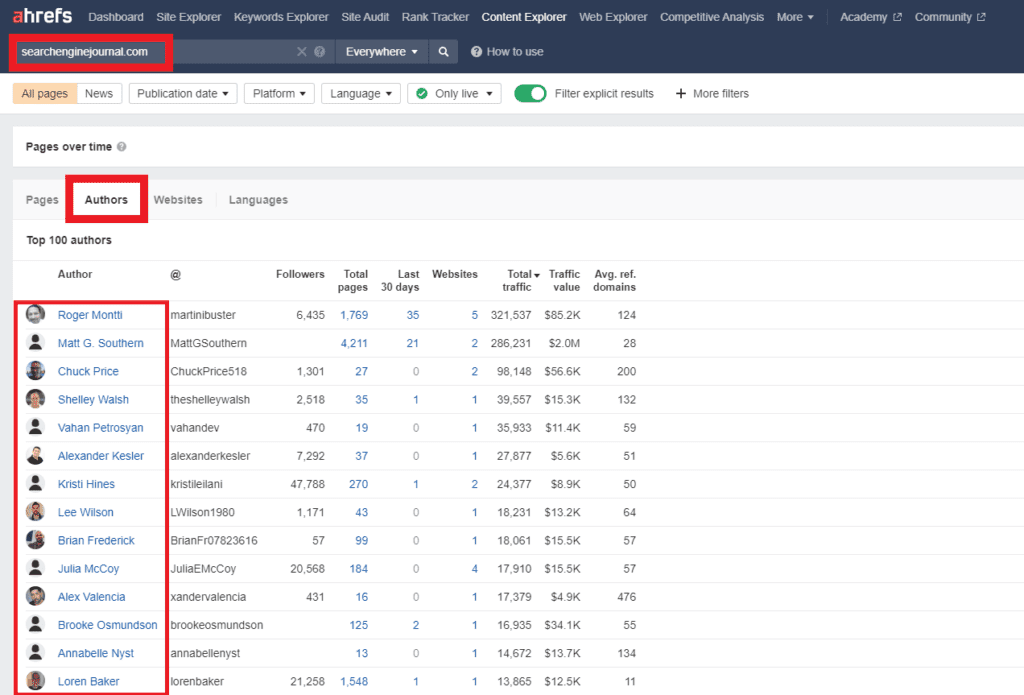
Set up your link-building plan
If you are serious about mastering relevant link building, having a solid link-building plan is a must. Make sure it stands on three key pillars: well-defined link building goals, concrete approaches to reaching those goals and, most importantly, a budget to execute each step of your plan. Here are some tips to make your link-building plan as comprehensive as you want it to be:
Outline your priorities
In other words, define what your target pages are. Though keep in mind that for the different stages of your SEO journey, you´ll need to prioritize different pages.
For instance, if you are building your backlink profile from scratch, you might want to kick off with an obvious solution — “money pages” aka product/service landing pages. Indeed, these can potentially bring more conversions. But the truth is that it's not always the right starting point, especially for newly-minted businesses seeking a more established online presence.
In this case, a safer though slower way would be concentrating on creating rich and user-centric content such as blog posts, valuable guides, and tutorials. These will secure you a more natural backlink profile simply because your materials match your audience’s needs and queries. And this is a straight way to improve your authority as an expert in a certain area in the eyes of search engines.
💡Pro-tip! People naturally tend to click on content that directly answers their “What is”, “How to” or “What to” questions rather than going to your product page and deduce if your product or service can help them find the answers.
However, if you still rely greatly on commercial pages, at least try to support their content with snippets of valuable information your audience won’t be able to find anywhere else online. This is how you can mix “business” with your reader’s “pleasure”: help them discover content they really need while scrolling through your commercial offers.
💡Pro-tip! For better results, make sure your content is optimized with relevant keywords. Additionally, work on quality information to back up your commercial pages. Finally, do not forget to link content internally.
But if your website already has a more or less “seasoned” backlink profile, focus on boosting average-ranking pages to bring them at least to top 3 in search results. Not to mention such parameters as anchor text, its distribution, search intent, target audience preferences, and more that directly impact your choice of target pages. So, analyze wisely depending on where you stand in your link-building endeavors.
Give your website a prior prep-up
Before you step up your relevant link building game, you need your platform to be fully ready for future success in terms of SEO. Resort to our previous tips on doing your backlink profile audit and complement it with proper website audit, including:
- Reorganize your URLs in logical sequence for better website navigation: make sure all your URLs are as descriptive as possible to be highly-visible to search engines. Do not forget about optimizing internal linking to guide website visitors and crawlers directly to relevant pages, which will significantly improve your website structure.
- Get rid of duplicate content: recurrently use canonical tags to show search engines preferred versions of duplicate pages to avoid penalties.
- Pay attention to page load speed and increase it if needed: to do this, you may compress file sizing and optimize code to improve page load time. As an extra measure, you may switch on browser caching and server-side caching to cut down on server response time and boost your website’s overall performance.
- Locate troublesome addresses to prevent future search engine crawling and indexing issues: you may start by checking for robots.txt file errors or issues with website's XML sitemap so that all your relevant pages are nicely indexed. Plus, address any occurring server errors such as 404 and 500 to facilitate website crawling.
- Detect and, if possible, recover broken links on your website: resort to 301 redirects for broken links to preserve link equity. As a regular measure, monitor the slightest website changes to make sure your content is not spoiled by broken links.
Analyze your competition
We’ve already covered some of the hacks when it comes to monitoring your competitors so you can freely use them in this very instance.
Additionally, you may leverage any of your SEO tools and identify your search competition by typing in target keywords to spot websites ranking for identical terms. To perform this in Ahrefs, go to the Keyword Explorer tab, insert a targeted keyword and press Search.
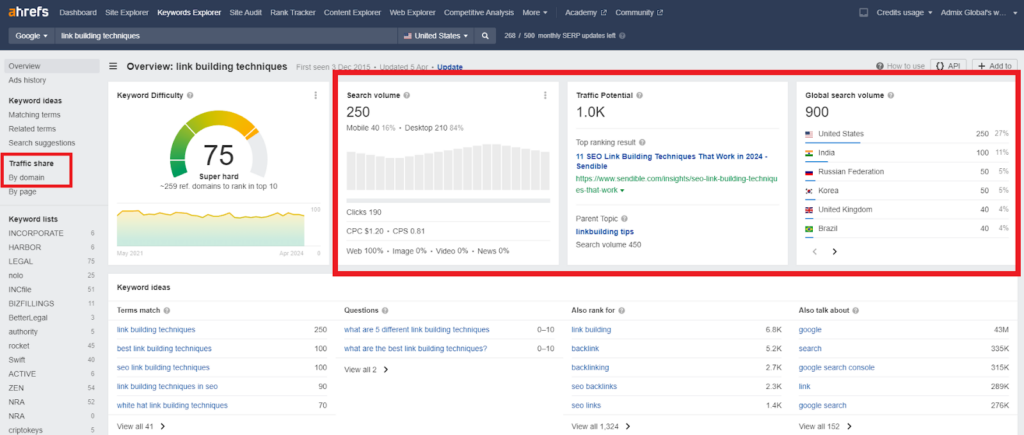
You’ll be automatically provided with data on the sought keyword including its difficulty, search volume, traffic potential, and search frequency worldwide. Next, click on the Traffic share tab (By domain) and get access to all domains ranking for “link-building techniques” keyword.
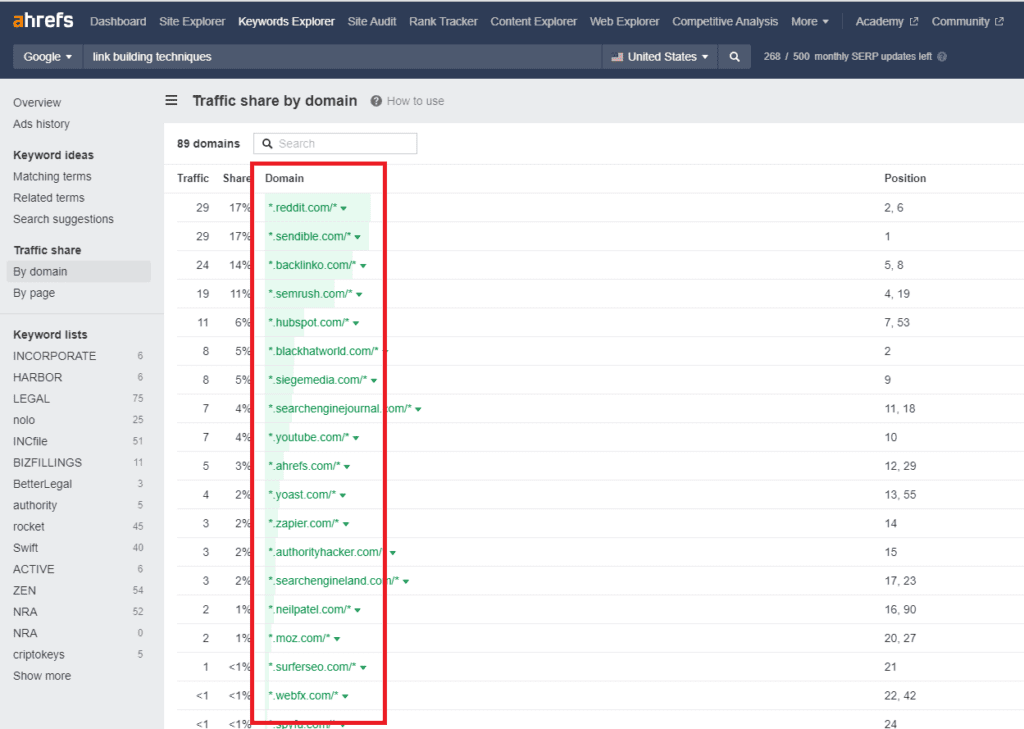
Count the number of links you need
After you are done with analyzing competitors, you will have a clearer picture on how many backlinks you need to rank better and outsrip your competition. A go-to roadmap to determining the exact number of links you should target at is as follows:
- Count the overall number of referring domains seen in your competitors’ profiles.
- Use filters to detect quality placements only, these could be DA/DR metrics from 40 and over.
- Narrow down your list to 10% of the initial number to kickstart targeted link-building.
💡Pro-tip! Talking about exact numbers of backlinks, it’s quite enough for a website to have 300-500 top-quality to gain organic traffic and improve SERP rankings. When it comes to local SEO, 20-30 backlinks is more than okay as competition is typically lower for narrow geographies.
Implement necessary link-building techniques
After the core analytical part of your link-building plan is done, it’s time to select empirical approaches to getting relevant backlinks. You may focus on certain techniques that match your current business needs or employ all of them at the same time:
- Guest blogging
- HARO link building
- Editorial links or niche edits
- Use of linkable assets/resource pages
- Directories/listicles placements
- Quality content production
- PR link building
Make a budget
Congratulations! You made it to the final part! Now that you know how to get relevant backlinks to your website, how many of them you need, and what techniques you can implement to make those rankings happen, get down to setting up your budget. Here’s a little checklist to help you do it hassle-free:
First and foremost, ask yourself how much you’re ready to spend on backlinking. From there, take into consideration such factors as quality of backlinks you aim to get, competition in your industry/niche, your overall financial means, etc.
- Make estimates and research the cost associated with different backlinking tactics. For example, some of them might require financial investment like paid directories or sponsored content. Others might require time only, for instance, quality blog copy.
- Define which backlinking tactics are worth investing the most. For instance, you may want to spend your resources on tactics that promise the highest potential ROI or focus on less expensive but having the most alignment with your business goals.
- Steadily monitor the output of your backlinking efforts and place more resources in those that prove to deliver the best results over time.
- Religiously analyze the ROI of your backlinking activities to have a grip on the effectiveness of your budget expenses. The typical metrics that will help you in that include search engine ranking, website traffic and, of course, conversions stemming from your backlinks.
💡Pro-tip! Businesses that rely heavily on relevant backlinks often see small SEO teams as not enough to generate sufficient link numbers. For this very reason, they typically allot a higher percentage of their SEO budget to link-building agencies. Yeah, these might truly charge more for their services, but their backlinks are of better quality, hence it´s way more rational to give them a bigger share of the budget.
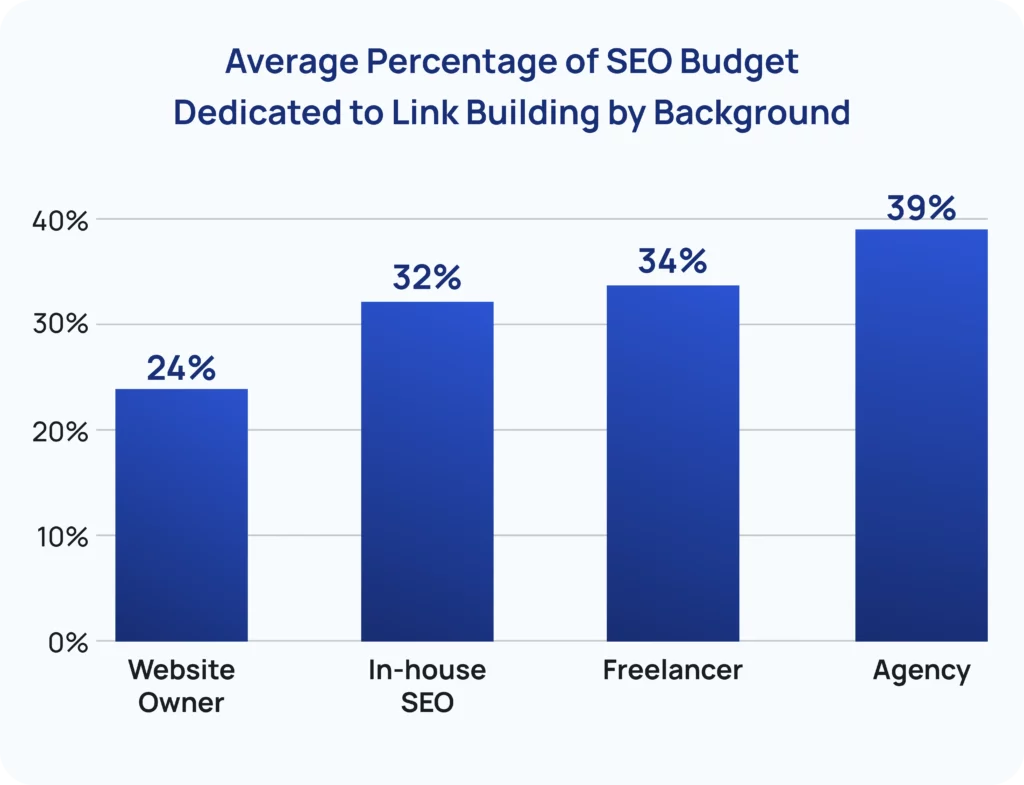
Source: Authority Hacker
Looking to make the most of your link-building budget? Editorial.Link is here to revamp your strategy, providing lifetime link value and cutting expenses wasted on dead-end links.
What Types of Relevant Links We Recommend
The best kinds of relevant backlinks are those acquired through white hat link building techniques. These are the only legitimate ways to source backlinks that will naturally boost your site's authority, credibility, and search engine rankings. The following relevant backlinks are considered white label and recommended to use:
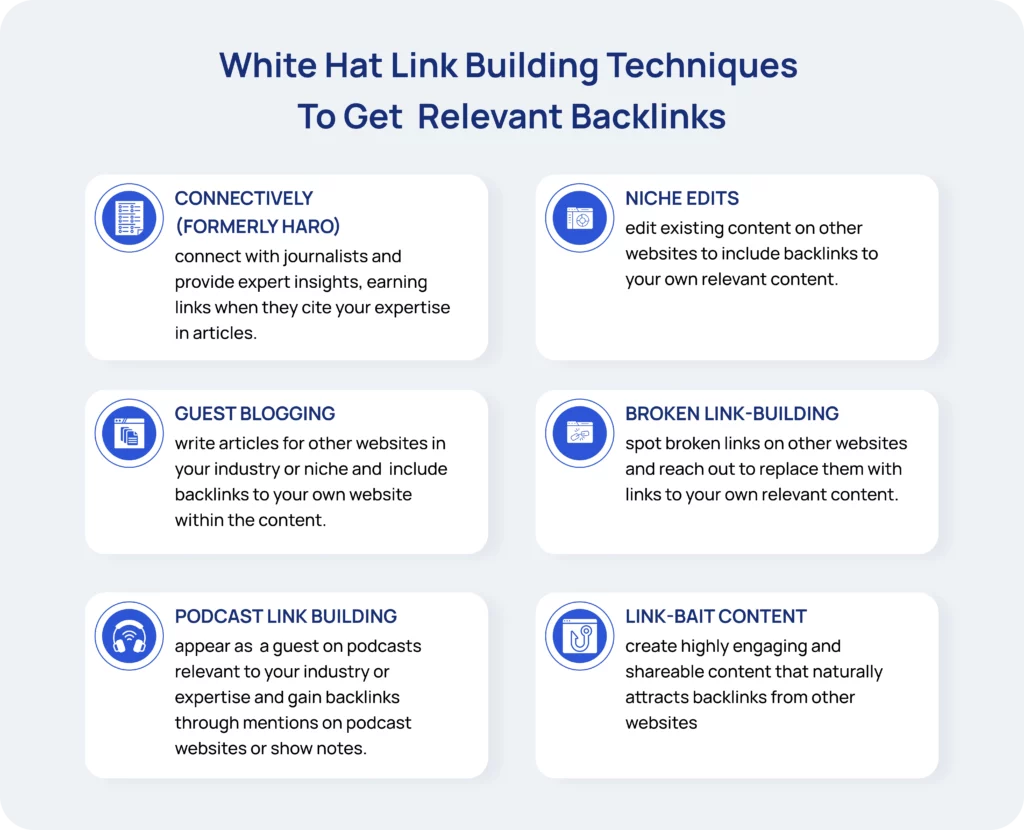
Meanwhile, here are our best picks for relevant backlinks!
Guest blogging
The notion of guest blogging speaks for itself: it’s all about submitting articles to websites corresponding to your industry or niche as a guest writer. Usually these articles include a byline and are presented by the editor of the host website as being written by an expert in a certain area of business. Typically such publications will grant a non-monetary reward such as a link back to the author’s personal website or social media accounts.
For example, a popular blog of a sales engagement platform features a guest post written by a CMO from a company specializing in sales development solutions. The article discusses, say, best tools for scraping lead phone numbers.

In the given scenario, the article is totally relevant to the interests of the host website’s target audience: sales professionals and business owners. This means more people will come to the website naturally, and those who are interested might check out the author's bio and company services.
Connectively (formerly Haro)
Initially designed for journalists to help them seek expert commentary for their articles, HARO quickly became a go-to-source of relevant backlinks for SEO professionals. All you need is to create a request, specify it with certain questions, set a deadline and wait for the community to respond.

Whenever you find an answer relevant to your content, you may accept the expert’s pitch.
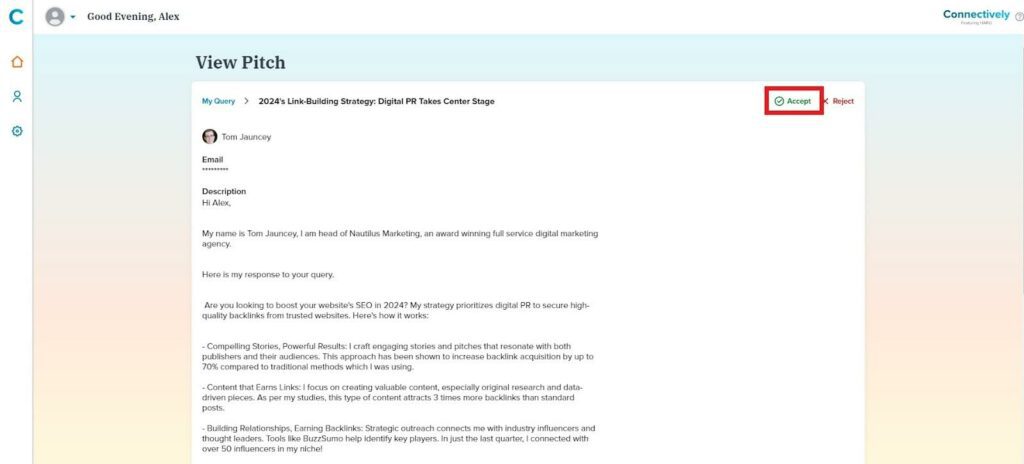
🎁 HARO Bonus Tips Pack!🤩
Since we are big on HARO, I've recently created a new query on how to get relevant backlinks.

Here are a couple of gem recommendations you may use for your business too!
Firstly, creating high-quality, shareable content cannot be overstated. We ensure our content provides real value, so readers naturally want to link to it. Secondly, guest posting on reputable websites within our industry has also been effective, providing exposure and naturally building our backlink profile. Moreover, using a resource link-building strategy creating high-quality resources that other websites might find useful and worthy of linking to, has shown significant results.
Finally, the power of relationships should never be underrated. Building solid relationships with influencers and other industry leaders opens the door for natural and meaningful backlinks. These four strategies have consistently performed regardless of the ever-changing digital marketing landscape
The first, the easiest and the most basic authority-building strategy is link reclamation — a practice of listening for and finding mentions of a brand, checking to see if that mention is also a link, and if not, connecting with an editor and asking them to make it a link. Here’s your go-to roadmap how it’s done.

We’ve had a lot of success in the last year by building relevant linkable assets that acquire links naturally over time. We use a two-pronged approach here.
First, we create an industry survey to collect data on a relevant topic to our industry. For us, it’s the subject of link building itself.
Then, we outreach to sites who talk about some of the topics within our survey and ask them to include our data in their articles. We get far more positive responses this way than we ever did with plain guest post outreach, because we have something uniquely valuable to contribute to their article.
Finally, we take this data and create a statistics article. The goal here is to rank for “link building statistics”. After ranking on page 1, we acquire many links naturally over time as writers look for statistics to include in their articles and link back to us.
Using tools like Featured and free journalists’ sources like B2B has given us warm leads to relevant publications. But what provides the most relevance for our brand is to target websites publishing top round-ups of the best language tools and apps. We send along a PR kit and request to be featured.
Niche edits
Niche edits (link inserts) conclude our top-picks of relevant backlink sources. This technique presupposes that links are placed into an existing article, blog post, or any other piece of content relevant to your niche or area of expertise after it’s been published.
The major benefit of inserting your links into reputable, highly-regarded content is that you benefit from relevancy, authority, and merit that the host page has already acquired.
For example, niche edits can be often seen in articles observing the best product or services trending in a certain year.

This particular article discusses over 25 handy work management tools, giving an opportunity for link-builders to suggest expanding the list with a new link-insertion. As editors often update such tool reviews annually, link-builders can already start proposing link insertions for the 2024 edition of the article.
💡Pro-tip! The typical reasons for website owners to accept your niche edits are broken link-building, mention link-building, and resource page link-building.
Here’s what you need to do in each instance:
- For broken link-building: find a no longer existing page analogical to yours. After tracking all the pages linking to it, email them and ask to update all the broken links to your page.
- For mention link-building: identify websites mentioning your business, product, service, or decision-maker. Ask the website to include a citation link along the mention.
- For resource page link-building: locate a page that provides certain resources to a specific online audience. Reach out to the website and offer to feature a similar resource from your website on their page.
Final thoughts
Backlink relevance means ensuring that the link matches the content, aligns with the audience's interests, stays current, and comes from authoritative sources.
Getting relevant backlinks takes time, but some people give in to the temptation of using shady tactics like black hat link building because they're impatient. However, this strategy won't help you. Instead, you'll end up with irrelevant backlinks that hurt your rankings and could get you flagged by Google for spam.
To get relevant backlinks for your website, stick to white hat link building methods ONLY. These include getting editorial links, using HARO queries, guest blogging, building links through podcasts, fixing broken links, creating link-worthy content, making niche edits.
Remember, relevant backlinks also come from a well-thought-out link-building strategy, which may require proper budgeting and link management. Don't hesitate to seek assistance from reputable link-building agencies like Editorial.Link. We're here to turn your backlinking efforts into relevant ones!












